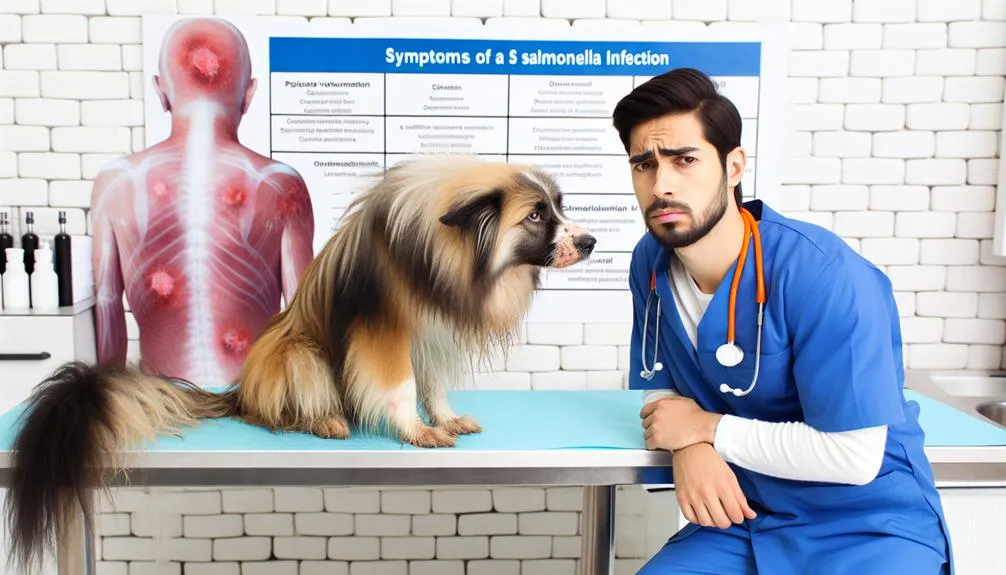
Can Dogs Get Salmonella
You might not realize it, but dogs can indeed contract Salmonella, a bacteria often associated with contaminated food. While raw meat is a common source, the implications for your pet's health—and yours—can be significant. Symptoms can range from mild to severe, and some dogs may carry the bacteria without showing any signs at all. So, what should you know about the risks and preventive measures? Understanding how to protect both your dog and your household becomes essential. Let's explore the specifics of Salmonella in dogs and what you can do about it.
Understanding Salmonella in Dogs
Salmonella is a type of bacteria that can pose significant health risks to dogs. This pathogen comprises various salmonella types, which can lead to gastrointestinal disturbances and other health issues in canines. Understanding these bacteria is essential for ensuring your dog's well-being.
Salmonella can be found in contaminated food, water, or surfaces, and it can affect dogs of all ages, breeds, and health statuses. The most common salmonella types associated with canine health include Salmonella enterica and Salmonella Typhimurium. These strains can cause symptoms such as diarrhea, vomiting, fever, and abdominal pain in infected dogs. It's important to recognize that not all dogs will exhibit symptoms; some may carry the bacteria asymptomatically, which poses risks to humans and other animals.
As a responsible pet owner, it's important to be aware of the sources of salmonella exposure. Raw diets, especially those containing raw meat or eggs, are common culprits. Additionally, cross-contamination in your kitchen can lead to infection, so maintaining proper hygiene while preparing your dog's food is essential.
If you suspect your dog has been exposed to salmonella or is showing symptoms, consulting a veterinarian promptly is important. Early diagnosis and treatment can mitigate severe health risks associated with this bacteria. Awareness and prevention are key to safeguarding your dog's health against salmonella and ensuring a happy, healthy life for your pet.
How Dogs Contract Salmonella
Dogs can contract Salmonella primarily through contaminated food sources, such as raw meat or poultry. Additionally, environmental exposure to infected feces or surfaces can pose significant risks. Understanding these transmission routes is essential for preventing infection in your dog.
Contaminated Food Sources
Contaminated food sources pose a significant risk for canine health, as they can harbor harmful bacteria like Salmonella. Dogs often contract Salmonella through raw diets, contaminated treats, or improperly handled pet food. It's essential to maintain food safety practices to minimize the risk of bacterial transmission.
Here's a breakdown of common contaminated food sources:
| Source Type | risk factors | Prevention Measures |
|---|---|---|
| Raw Diets | High levels of bacteria | Use reputable suppliers |
| Contaminated Treats | Poor manufacturing | Purchase from trusted brands |
| Inadequate Cooking | Cross contamination | Follow proper cooking practices |
| Handler Hygiene | Bacteria transfer | Wash hands before handling food |
Environmental Exposure Risks
Bacteria like Salmonella can also spread through environmental exposure, posing risks beyond just contaminated food sources. Dogs can contract Salmonella through various pathways, especially when they come into contact with contaminated surfaces or materials. Understanding these risks is vital for maintaining your dog's health.
Here are some common environmental exposure risks for dogs:
- Wildlife interactions: Dogs may encounter wildlife feces or carcasses during walks, which can contain Salmonella.
- Contaminated soil: Soil can harbor Salmonella from animal waste, making it a potential source of infection when dogs dig or play.
- Shared water sources: Puddles or stagnant water might be contaminated with bacteria from wildlife.
- Neglected hygiene practices: Poor household hygiene, such as not cleaning up after pets, can lead to the spread of Salmonella.
- Cross-contamination: Moving between different environments without proper cleaning can introduce Salmonella to your home.
Symptoms of Salmonella Infection

Salmonella infection can manifest through various symptoms that are vital for pet owners to recognize. Dogs infected with Salmonella may exhibit gastrointestinal disturbances, which are among the most common symptoms. You might notice vomiting, diarrhea, and abdominal pain. The diarrhea could be watery or bloody, and it typically occurs within 6 to 72 hours post-exposure to the bacteria.
Symptom severity can vary markedly depending on the dog's overall health and age. Puppies and older dogs are usually more susceptible to severe symptoms, which may include lethargy, fever, and loss of appetite. In some cases, symptoms can escalate to dehydration due to ongoing diarrhea and vomiting, making it essential for you to monitor your dog's hydration levels.
The duration of the infection can also differ. While some dogs might recover within a few days, others may experience symptoms for a week or longer. If the infection becomes severe or if your dog has underlying health issues, the duration of symptoms may increase, leading to potential complications.
It's important to keep an eye on your dog's behavior and health during this period. If you observe severe symptoms or prolonged infection duration, seeking veterinary advice is paramount. Early intervention can help prevent serious complications and guarantee your pet's recovery. Being vigilant about these symptoms will help you act swiftly to safeguard your dog's health.
Diagnosis and Treatment Options
When your dog shows symptoms of a Salmonella infection, quick diagnosis is essential. Diagnostic testing methods typically include stool cultures and blood tests to confirm the presence of the bacteria. Once diagnosed, Treatment options may involve supportive care and, in some cases, antibiotics, depending on the severity of the infection.
Symptoms of Salmonella Infection
A variety of symptoms can indicate a salmonella infection in dogs, and recognizing them early is vital for effective treatment. The symptoms can range in severity, and understanding the symptoms overview is important for pet owners.
Here are some common signs to watch for:
- Diarrhea: Often watery and may contain blood or mucus.
- Vomiting: Frequent episodes can lead to dehydration.
- Fever: Elevated body temperature may indicate infection severity.
- Lethargy: A noticeable decrease in energy or interest in activities.
- Loss of Appetite: Refusal to eat can be a sign of gastrointestinal distress.
If you observe any of these symptoms in your dog, it's important to consult your veterinarian promptly. Early diagnosis and treatment can help manage the infection effectively and prevent complications. Keep in mind that the severity of symptoms can vary widely among dogs, and some may exhibit mild signs while others may become severely ill. Monitoring your dog's health and being attentive to changes can make a significant difference in their recovery.
Diagnostic Testing Methods
Recognizing the symptoms of salmonella infection is just the first step; proper diagnostic testing is essential for confirming the presence of the bacteria in your dog. Veterinarians typically employ a variety of diagnostic procedures to assess whether salmonella is the culprit. One of the most common methods involves fecal testing, where a stool sample is analyzed for the presence of salmonella bacteria. This method is preferred due to its relatively straightforward nature and non-invasive approach.
In some cases, blood tests may also be conducted to check for signs of systemic infection and assess overall health. While these tests can provide valuable information, testing accuracy can vary, highlighting the importance of a thorough diagnostic approach. Additional procedures, such as cultures or PCR tests, may be utilized to enhance the reliability of the diagnosis and pinpoint the specific strain of salmonella.
It's vital to understand that timely and accurate diagnostic testing not only confirms infection but also guides the appropriate response. If you suspect your dog might have been exposed to salmonella, consult your veterinarian promptly for an accurate diagnosis and effective management.
Treatment and Recovery Options
Effective treatment and recovery from a salmonella infection in dogs typically involve a combination of supportive care and, in some cases, antimicrobial therapy. It's vital to consult your veterinarian for a proper diagnosis and treatment plan. While professional care is essential, you might also take into account some home remedies and dietary adjustments to support your dog's recovery.
Here are some options to think about:
- Hydration: Make sure your dog stays hydrated, as diarrhea can lead to dehydration.
- Bland Diet: Introduce a bland diet, such as boiled chicken and rice, to ease digestive distress.
- Probiotics: Contemplate adding probiotics to your dog's diet to help restore gut flora.
- Monitor Symptoms: Keep a close watch on any changes in symptoms or behavior, and consult your vet if things worsen.
- Rest: Provide a quiet, comfortable space for your dog to recover and rest.
Prevention Strategies for Pet Owners

Preventing salmonella exposure in your dog requires a multifaceted approach that focuses on hygiene and food safety. First, implementing strict hygiene practices in your home is vital. Always wash your hands thoroughly with soap and water after handling raw meat or your dog's food. This simple step helps prevent cross-contamination. Additionally, make certain that your dog's feeding area is kept clean; regularly sanitize food bowls and feeding surfaces to minimize bacterial growth.
When it comes to safe feeding, it is important to choose high-quality dog food and treats. Opt for commercially prepared foods that adhere to safety standards, and avoid raw diets unless advised by a veterinarian. If you do feed your dog raw food, take extra precautions: store it at appropriate temperatures, and make sure all utensils and surfaces are sanitized after preparation.
Moreover, be cautious about your dog's interactions with other animals, especially in communal or outdoor settings. Encourage your dog to avoid consuming feces or scavenging for food, as these can be sources of salmonella.
When to Consult a Veterinarian
Even with diligent prevention strategies, there are instances when your dog may still be at risk for salmonella infection. If you suspect that your pet has contracted this bacteria, it's vital to consult a veterinarian promptly. Early detection and treatment can mitigate serious health issues. Be aware of the signs that may indicate salmonella infection in your dog, as many salmonella myths can lead to misunderstandings about pet safety.
You should reach out to your veterinarian if your dog exhibits any of the following symptoms:
- Persistent vomiting or diarrhea
- Severe lethargy or weakness
- Loss of appetite or refusal to eat
- Fever or other signs of infection
- Abdominal pain or discomfort
These symptoms can signal a serious health issue, and it's essential not to dismiss them. Additionally, if your dog has recently consumed raw food or been in contact with contaminated surfaces, mention this to your veterinarian; this information can aid in diagnosis.
Frequently Asked Questions
Can Dogs Transmit Salmonella to Humans?
Yes, dogs can transmit salmonella to humans through feces or contaminated surfaces. Human symptoms may include diarrhea, fever, and abdominal cramps, highlighting the importance of hygiene and regular veterinary care to minimize transmission routes.
Are Certain Dog Breeds More Susceptible to Salmonella?
When considering dog breed susceptibility, certain breeds may have a higher infection risk due to factors like immune system strength and health predispositions. It's wise to monitor your dog's health to minimize any potential risks.
Is There a Vaccine for Salmonella in Dogs?
Currently, there isn't a specific vaccine for salmonella in dogs. However, understanding vaccine efficacy and maintaining a proper vaccination schedule for other preventable diseases can help keep your dog healthy and reduce infection risks.
Can Salmonella Affect Puppies Differently Than Adult Dogs?
Salmonella can affect puppies differently than adult dogs. Puppies often exhibit more severe symptoms due to their developing immune systems, while adult immunity typically provides better protection, reducing the severity of infection in older dogs.
What Foods Are Most Likely to Cause Salmonella in Dogs?
Imagine a chef handling raw chicken without proper precautions. Similarly, raw diets can expose your dog to salmonella. Foods like undercooked eggs, poultry, and contaminated produce pose significant food safety risks for your furry friend.
Conclusion
To sum up, while it may seem surprising, dogs can indeed get Salmonella, much like humans. This bacteria isn't just a concern for them; it can also affect you and your family. By understanding how dogs contract it and recognizing the symptoms, you can take proactive steps to protect your furry friend. Remember, good hygiene and regular vet check-ups are your best defenses. So, next time you think about feeding your dog raw meat, consider the risks involved.
You may also like
Archives
Calendar
| M | T | W | T | F | S | S |
|---|---|---|---|---|---|---|
| 1 | 2 | 3 | 4 | 5 | 6 | |
| 7 | 8 | 9 | 10 | 11 | 12 | 13 |
| 14 | 15 | 16 | 17 | 18 | 19 | 20 |
| 21 | 22 | 23 | 24 | 25 | 26 | 27 |
| 28 | 29 | 30 | ||||
Leave a Reply